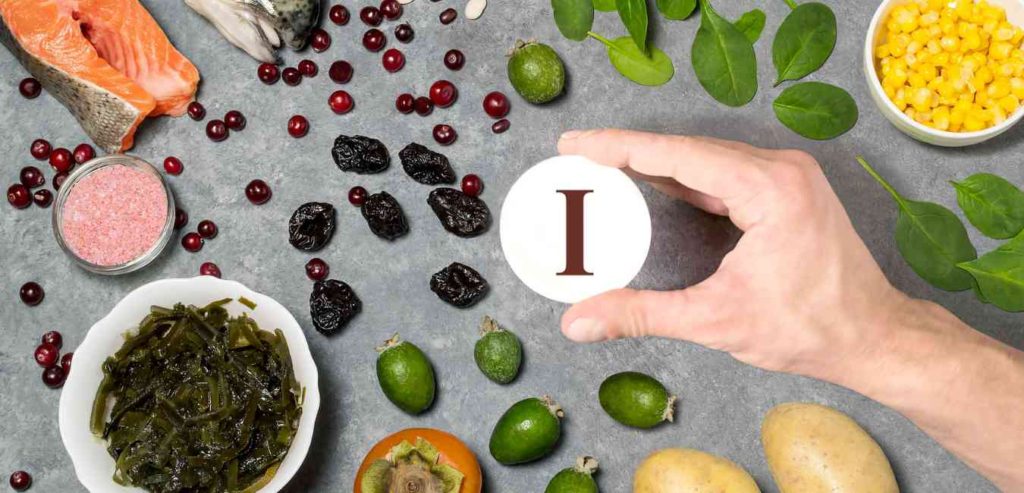
Today I’m going to break down any of your old school thoughts on iodine consumption. I’m going to tell you all about why we need iodine, the negative effects of too little and too much iodine, and what the optimal doses are.
Why Do We Need Iodine?
Iodine is a trace element and has one very important job to do in the body, which is to synthesize thyroid hormones. In order to create T4 and T3, which are two of your thyroid hormones, you need a combination of the amino acid tyrosine and iodine.
Iodine Deficiency
Iodine deficiency is one of the most common causes of hypothyroidism, which is when you have an underactive thyroid. Most people think that they should consume a ton of iodine in order to reverse this. However, consuming too much iodine is a whole other problem. You want to make sure you are getting JUST the right amount. Not too much and not too little. Too much iodine is actually ALSO associated with hypothyroidism. Excessive iodine intake can also cause thyroid autoimmunity. This means someone can develop antibodies that will attack their thyroid, causing an autoimmune disease like Hashimoto’s.
Why Excess Iodine Consumption May Harm Your Thyroid
To explain, iodine is processed within the thyroid gland, hydrogen peroxide, a free radical, is released. Basically, free radicals cause damage to the body. Luckily, Selenium, another trace mineral, will neutralize this free radical. However, that is only if you have enough Selenium. So if you have excess iodine from food and supplements, the production of free radicals can damage the thyroid tissue directly. The thyroid cells will then release something called DAMPs, Danger Associated Molecular Patterns, which can trigger the autoimmune process. So by consuming too much iodine, you could potentially be causing thyroid cell destruction.
Relevant Iodine Consumption and Thyroid Antibodies Studies
In 2003, scientists conducted a study on 45 patients who had hypothyroidism as a result of Hashimoto’s. Group 1 was placed on an iodine restricted diet of less than 100 mcg per day, while Group 2 was not. After 3 months, Group 1 had 78.3% of the group return to a euthyroid state, which means a normally functioning thyroid, just by restricting their iodine intake. Group 2 only had 45.5% of the patients experience this improvement. [1]
Another study looked at a population of 302 school children in a town in Greece that had previously been iodine deficient. Scientists compared the findings to a similar study conducted 7 years previously in the same area. The data comparison showed that a threefold increase occurred in these schoolchildren in regards to a prevalence of autoimmune thyroiditis. Since the elimination of iodine deficiency in this area, an increase of prevalence in autoimmune thyroiditis has occurred. [2]
Scientists also conducted a similar study in Turkey, on 1733 adolescent subjects. Two regions of Turkey were examined after 2 years of iodization. The results showed that iodine supplementation did eliminate the iodine deficiency in the Eastern Black Sea Region, but this also increased the prevalence of autoimmune thyroiditis and thyroid dysfunction. [3]
Global Health Organizations and Iodine Consumption
Global health organizations started adding iodine to salt and other fortified foods because, at one point, most of the world was iodine deficient. However, after achieving their goal of eliminating iodine deficiency, the World Health Organization realized that too much iodine intake triggered thyroid disease.
How Much To Consume
The recommended daily allowance for iodine intake is 150 mcg for non-pregnant adults. Pregnant adults need to take a higher dose of 220-250 mcg. In addition, breastfeeding women are encouraged to consume as much as 290 mcg. The American Thyroid Association advises against the consumption of iodine and kelp supplements with an excess of 500 mcg of iodine daily. The most tolerable upper limit is 1,100 mcg of iodine per day. Nevertheless, after I just explained the harm that iodine can do to the thyroid, you may want to reconsider ever taking that much. Doses as low as 300 mcg can exacerbate autoimmune disease and thyroid dysfunction.
The Issue With Determing Iodine Consumption Amount
The issue is that it is extremely difficult to tell how much iodine you are consuming daily.
Sources of Iodine
If you consume iodized salt, that is obviously one source of iodine. Food sources high in iodine include kelp, seaweed, spirulina, chlorella, fish (like cod and tuna), shellfish (such as shrimp), egg yolks, dairy, bread, and other commercial baked goods.
If Your Iodine Levels Are Low
So if you have done lab testing to look at your iodine levels and they are proven to be low, you may want to look at your diet first. If you decide to supplement with iodine and not change your diet, consider only taking doses on the lower end of the spectrum such as 100-200 mcg per day or even less for a short period of time to normalize your levels. Eventually, you will want to reduce the amount you are supplementing with or adjust your diet accordingly.
If Your Iodine Levels Are Too High
If you have done lab testing and your iodine levels are too high, or you have Hashimoto’s thyroiditis and suspect you may have high iodine levels, consider starting an iodine restriction diet for 2-3 months at less than 100 mcg of iodine per day. Then examine and adjust your diet to normalize your consumption of iodine to the recommended daily allowance. One other recommendation is to supplement with selenium in order to balance out any damage done to your thyroid from excess iodine intake. Of course, always speak to your doctor about making any of these changes because this is not medical advice.
Takeaway
What are your thoughts on iodine? Are you caught up in the old school of thought about this mineral or were you already aware of the potential dangers of excess supplementation?
If you have more iodine consumption questions, book your free call here!
References:
Yoon SJ, Choit SR, Kim DM, et al. The effect of iodine restriction on thyroid function in patients with hypothyroidism due to Hashimoto’s thyroiditis. Yonsi Med J. 2003 Apr 30;44(2):227-35. [1] https://pubmed.ncbi.nlm.nih.gov/12728462/
Zois C, Stavrou I, Kalogera C, et al. High prevalence of autoimmune thyroiditis in school children after elimination of iodine deficiency in northwestern Greece. Thyroid. 2003 May;13(5):485-9. [2] https://pubmed.ncbi.nlm.nih.gov/12855016/
High prevalence of thyroid dysfunction and autoimmune thyroiditis in adolescents after elimination of iodine deficiency in the Eastern Black Sea Region of Turkey. Thyroid 2006 Dec;16(12):1265-71. [3] https://pubmed.ncbi.nlm.nih.gov/17199437/

Recent Comments